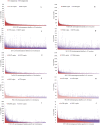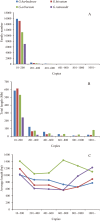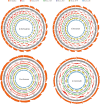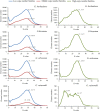Genome-Wide Survey and Comparative Analysis of Long Terminal Repeat (LTR) Retrotransposon Families in Four Gossypium Species
- PMID: 29925876
- PMCID: PMC6010443
- DOI: 10.1038/s41598-018-27589-6
Genome-Wide Survey and Comparative Analysis of Long Terminal Repeat (LTR) Retrotransposon Families in Four Gossypium Species
Abstract
Long terminal repeat (LTR) retrotransposon is the most abundant DNA component and is largely responsible for plant genome size variation. Although it has been studied in plant species, very limited data is available for cotton, the most important fiber and texture crop. In this study, we performed a comprehensive analysis of LTR retrotransposon families across four cotton species. In tetraploid Gossypium species, LTR retrotransposon families from the progenitor D genome had more copies in D-subgenome, and families from the progenitor A genome had more copies in A-subgenome. Some LTR retrotransposon families that insert after polyploid formation may still distribute the majority of its copies in one of the subgenomes. The data also shows that families of 10~200 copies are abundant and they have a great influence on the Gossypium genome size; on the contrary, a small number of high copy LTR retrotransposon families have less contribution to the genome size. Kimura distance distribution indicates that high copy number family is not a recent outbreak, and there is no obvious relationship between family copy number and the period of evolution. Further analysis reveals that each LTR retrotransposon family may have their own distribution characteristics in cotton.
Conflict of interest statement
The authors declare no competing interests.
Figures






Similar articles
-
Exceptional diversity, non-random distribution, and rapid evolution of retroelements in the B73 maize genome.PLoS Genet. 2009 Nov;5(11):e1000732. doi: 10.1371/journal.pgen.1000732. Epub 2009 Nov 20. PLoS Genet. 2009. PMID: 19936065 Free PMC article.
-
The cotton centromere contains a Ty3-gypsy-like LTR retroelement.PLoS One. 2012;7(4):e35261. doi: 10.1371/journal.pone.0035261. Epub 2012 Apr 19. PLoS One. 2012. PMID: 22536361 Free PMC article.
-
Long Terminal Repeat Retrotransposon Content in Eight Diploid Sunflower Species Inferred from Next-Generation Sequence Data.G3 (Bethesda). 2016 Aug 9;6(8):2299-308. doi: 10.1534/g3.116.029082. G3 (Bethesda). 2016. PMID: 27233667 Free PMC article.
-
LTR retrotransposons and flowering plant genome size: emergence of the increase/decrease model.Cytogenet Genome Res. 2005;110(1-4):91-107. doi: 10.1159/000084941. Cytogenet Genome Res. 2005. PMID: 16093661 Review.
-
Co-evolution of plant LTR-retrotransposons and their host genomes.Protein Cell. 2013 Jul;4(7):493-501. doi: 10.1007/s13238-013-3037-6. Epub 2013 Jun 23. Protein Cell. 2013. PMID: 23794032 Free PMC article. Review.
Cited by
-
Molecular insights into the VIRESCENS amino acid sequence and its implication in anthocyanin production in red- and yellow-fruited cultivars of date palm.Sci Rep. 2023 Nov 24;13(1):20688. doi: 10.1038/s41598-023-47604-9. Sci Rep. 2023. PMID: 38001227 Free PMC article.
-
Molecular and Cytogenetic Analysis of rDNA Evolution in Crepis Sensu Lato.Int J Mol Sci. 2022 Mar 26;23(7):3643. doi: 10.3390/ijms23073643. Int J Mol Sci. 2022. PMID: 35409003 Free PMC article.
-
Transposable elements in Rosaceae: insights into genome evolution, expression dynamics, and syntenic gene regulation.Hortic Res. 2024 Apr 26;11(6):uhae118. doi: 10.1093/hr/uhae118. eCollection 2024 Jun. Hortic Res. 2024. PMID: 38919560 Free PMC article.
-
Comparative Analysis of Transposable Elements and the Identification of Candidate Centromeric Elements in the Prunus Subgenus Cerasus and Its Relatives.Genes (Basel). 2022 Apr 2;13(4):641. doi: 10.3390/genes13040641. Genes (Basel). 2022. PMID: 35456447 Free PMC article.
-
In silico mining and FISH mapping of a chromosome-specific satellite DNA in Capsicum annuum L.Genes Genomics. 2019 Sep;41(9):1001-1006. doi: 10.1007/s13258-019-00832-8. Epub 2019 May 27. Genes Genomics. 2019. PMID: 31134590
References
Publication types
MeSH terms
Substances
LinkOut - more resources
Full Text Sources
Other Literature Sources

